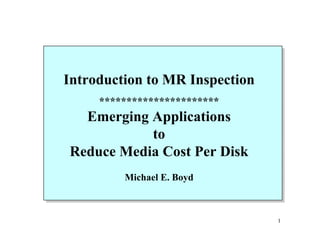
MStestscenario
- 1. Introduction to MR Inspection ********************** Emerging Applications to Reduce Media Cost Per Disk Michael E. Boyd 1
- 2. Areal Density and Impact on Media Test 14 1997 Forecasted 95 mm Disk Pricing 1 0 .9 12 0 .8 10 0 .7 8 0 .6 T e s t T im e 0 .5$ P e r D is k (M in /D is k ) 6 0 .4 4 0 .3 Test Time Growth 0 .2 2 0 .1 0 0 97 98 99 00 COST PRODUCTIVITY FACTORS Increasing areal density creates test Yields time dilemma Test methodology Budget for test roughly fixed Equipment throughput and cost – 15-20 % of media cost Equipment utilization Continued pressure on disk pricing 2
- 3. Test Requirements Drive Requirements Magnetics Defects Glide Technology Driven Cost Driven Scratches TA’s TPI vs % Coverage Shallow Defects Consumables Low Glide Contamination Test Strategy 3
- 4. Test Challenges Future Test strategies of media makers diverge: Parallelism in Test More magnetics testing, less single bit defect testing More emphasis on disk mechanics (glide and TA’s) Optical Glide Optical Certification Optically assisted testing Discrete Testers 4
- 5. Possible New Additions to Final Test Optical Testing: Traditional focus has been to replace glide or certification testing Optical systems for glide have had an issue with sensitivity vs. throughput Optical systems can find magnetic defects, however over-rejection is the problem MR Glide: Scanning with MR drive head on an erased disk Best sensor for detecting contact thermal asperities, non-contact bump/pit thermal signals, and scratches Has not been utilized in production testing 5
- 6. Defining Optical, Certification, PZT, & MR Glide Signals Optical Signals, are Bright Field from Specular Light, & Dark Field from Scattered Light. Optical Signals Cert. Missing Pulse Signal MR Glide Signal, is Magnetic Signal from the Defect’s Edges, & Mass Spin-Valve Signal. Non-contact MR Glide Signal PZT Glide Signal 6
- 7. Signal Characterstics from Reference 10m x 10m ~1.25 in Bump Defect AFM Microgaph Optical Signals Non-contact MR Glide Bright & Dark Field Contact PZT Glide 7
- 8. Signal Characterstics from Reference 10m x 10m ~2 in Pit Defect AFM Micrograph Optical Signals Non-contact MR Glide Bright & Dark Field Non-contact PZT Glide 8
- 9. Based on Defects Presented Bump/Pit Signal Polarity to Type & Defect Signal Amplitude to Size Dependence Signal Bump/Pit Signal Defect Signal Type Polarity to Type Amplitude to Size Optical Bright Field Yes Yes Optical Dark Field No Yes PZT Glide ? ? MR Glide Yes Yes 9
- 10. PS5100 Signal vs MR Glide Signal on Scratch Defect PS5100 Microscope Image ~2.5m Width PS5100 Optical Signal Non-contact MR Glide Signal 10
- 11. PS5100 Signal vs MR Glide Signal on Polishing Defect PS5100 Microscope Image ~40m x 30m PS5100 Optical Signal Non-contact MR Glide Signal 11
- 12. PS5100 Signal vs MR Glide Signal on Bump Like Binary P.D. PS5100 Microscope Image ~40m x 20m PS5100 Optical Signal Non-contact MR Glide Signal 12
- 13. PS5100 Signal vs MR Glide Signal on Head Slap PS5100 Microscope Image ~ 30m x 10m PS5100 Optical Signal Contact MR Glide Signal 13
- 14. Based on Defects Presented PS5100 Error Signal Characteristics vs MR Glide Error Signal Characteristics Defect PS5100 MR Glide Type Error Signal Error Signal Scratch Dark Field Only Magnetic Only P.D. Bright Field Only Thermal Only Head Slap Bright & Dark Field Thermal Asperity Binary P.D. Bright Field Only Thermal Only 14
- 15. Typical Test Cycle 10-25 seconds 10-20 seconds 20-35 seconds 120-150 seconds Burnish Optical Scan Glide Certify • Mechanical Process • Pre-glide screen • Using PZT or AE Heads • Defect Testing • Removes Surface • Saves heads • Verify surface asperities • Defects below specified Asperities • Increases are below set limits size and count Throughput • Typically one event fails disk • Parametrics within set ranges • OD, MD, ID • Every disk or sample 15
- 16. MG250 Missing Pulse Errors vs PS5100 Bright and Dark Field Errors 16
- 17. MG250 Missing Pulse Errors vs MR Glide Errors 17
- 18. Correlation of Cert. Missing Pulse Errors to PS5100 and MR Glide Error Type Correlation MR Glide Very Good (~85%) PS5100 Good (~70%) With Proper Adjustment of Error Detection Thresholds Overkill and Underkill is Minimized 18
- 19. MG250 Certification Errors vs. EPS Errors 19
- 20. Possible Test Sequence Grade 1 PZT Glide Only Pass disks Optical Test Grade 2 and/or MR Glide PZT Glide Ceritify by Zone Pass Disks Fail Disks 20
- 21. One Estimate of Savings Yield Time Savings Savings/Disk Grade 1 15% 135 sec 20 sec Grade 2 80% 15 sec 12 sec Grade 3 5% 165 sec 8 sec Total Savings 40 sec 21
- 22. Conclusions Correlation studies suggest that there is to sizeable under and over-rejection to have Optical or MR glide replace traditional glide and certification testing If over-rejection is minimized valuable yield and throughput benefits can be obtained with appropriate sequential testing These tests should also improve isolation of critical defects such as scratches, TA’s, and shallow defects 22
